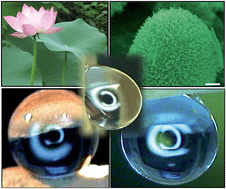Anomalous adhesive superhydrophobicity on aligned ZnO nanowire arrays grown on a lotus leaf†
Abstract
We demonstrate a conceptually novel approach to incorporate biological substrates with synthetic

* Corresponding authors
a
Department of Materials Science and Engineering, National Tsing Hua University, Hsinchu, Taiwan ROC
E-mail:
ljchen@mx.nthu.edu.tw
Fax: +886-3-5718328
Tel: +886-3-5731166
We demonstrate a conceptually novel approach to incorporate biological substrates with synthetic

 Please wait while we load your content...
Something went wrong. Try again?
Please wait while we load your content...
Something went wrong. Try again?
M. Afsal and L. Chen, J. Mater. Chem., 2011, 21, 18061 DOI: 10.1039/C1JM12226F
To request permission to reproduce material from this article, please go to the Copyright Clearance Center request page.
If you are an author contributing to an RSC publication, you do not need to request permission provided correct acknowledgement is given.
If you are the author of this article, you do not need to request permission to reproduce figures and diagrams provided correct acknowledgement is given. If you want to reproduce the whole article in a third-party publication (excluding your thesis/dissertation for which permission is not required) please go to the Copyright Clearance Center request page.
Read more about how to correctly acknowledge RSC content.
 Fetching data from CrossRef.
Fetching data from CrossRef.
This may take some time to load.
Loading related content
